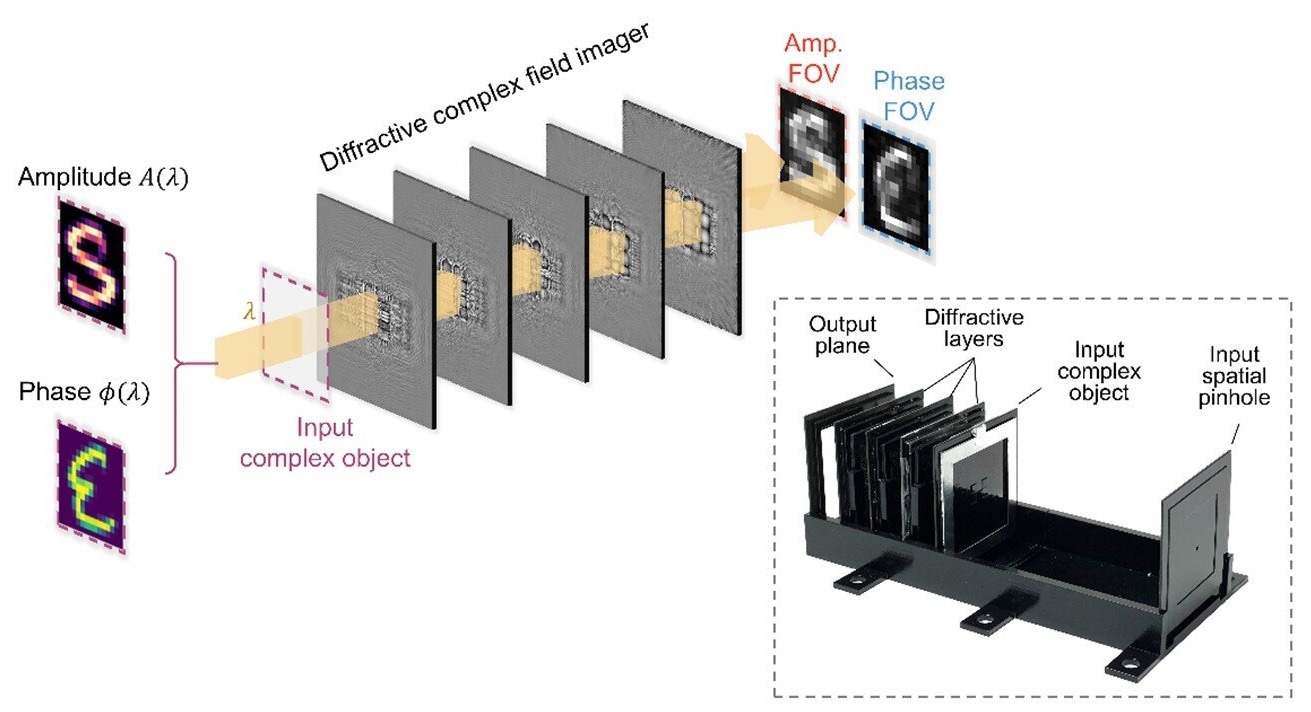Reviewed by Lexie CornerJun 3 2024
Scientists at the University of California, Los Angeles (UCLA) have achieved a significant breakthrough in optical imaging technology. They have created an innovative all-optical complex field imager that records optical field amplitude and phase data without requiring digital processing. The study has been published in Light: Science & Applications.
 All-optical complex field imaging using diffractive processors. New UCLA imager acquires amplitude and phase in. Image Credit: University of California, Los Angeles
All-optical complex field imaging using diffractive processors. New UCLA imager acquires amplitude and phase in. Image Credit: University of California, Los Angeles
Numerous industries, including biomedical imaging, security, sensing, and material science, stand to benefit significantly from this breakthrough.
A Paradigm Shift in Imaging
Conventional optical imaging systems use intensity-based sensors, which are limited to capturing light's amplitude and ignoring vital phase information. For thorough sample analysis, phase information offers insights into structural characteristics like absorption and refractive index distributions.
The existing approaches for obtaining phase information require intricate holographic or interferometric systems, further enhanced by iterative phase retrieval algorithms. This leads to a higher computational and hardware overhead.
To circumvent these restrictions, a UCLA group led by Professor Aydogan Ozcan has created a unique complex field imager. This novel device modulates incoming complex fields via a sequence of diffractive surfaces optimized for deep learning. These surfaces produce two separate imaging channels by converting the amplitude and phase of the input fields into intensity distributions on the sensor plane. This method greatly streamlines the imaging process by eliminating the requirement for digital reconstruction algorithms.
The diffractive surfaces of the new complex field imager are arranged spatially to facilitate phase-to-intensity and amplitude-to-amplitude transformations. The device can use these transformations to measure the amplitude and phase profiles of the input complex fields directly. Due to its small optical design, which spans about 100 wavelengths axially, the imager can be easily integrated into current optical systems.
The researchers validated their design using 3D-printed prototypes operating in the terahertz spectrum. The experimental results demonstrated high accuracy, with the phase and amplitude channel images closely matching the results of numerical simulations. This proof-of-concept demonstration highlights the complex field imager's potential for practical uses.
Applications and Future Prospects
This advancement in complex field imaging technology opens up a range of applications. In the biomedical field, the imager can be used for noninvasive, real-time monitoring of cells and tissues, offering vital information during medical procedures. Its efficient and small design makes it suitable for incorporation into miniature microscopes and endoscopic devices, which could improve intraoperative imaging and point-of-care diagnostics.
The imager can aid in the development of portable lab-on-a-chip sensors for quick detection of pollutants and microorganisms in environmental monitoring. Thanks to its portability and simplicity of use, it is the perfect tool for on-site quantitative analysis, expediting environmental assessment.
Additionally, the complex field imager has the potential to be used in industrial settings for quick material inspection. Its capacity to obtain intricate structural data without requiring large amounts of computational power or cumbersome equipment makes it an invaluable tool for material analysis and quality assurance.
The creation of the all-optical complex field imager has been a significant development. This technology facilitates the direct acquisition of amplitude and phase data without needing digital processing, thereby streamlining the imaging process and expanding the range of possible uses. The impact of this innovation is anticipated to increase as the research team continues to improve and expand upon their designs, providing fresh avenues for both practical and scientific applications in a range of fields.
Journal Reference:
Li, J., et al. (2024) All-optical complex field imaging using diffractive processors. Light: Science & Applications. doi.org/10.1038/s41377-024-01482-6